All women like to enhance their body shape and feel more confident, so they go with plastic surgery.
One of the most common cosmetic procedures now is breast augmentation. If you have born with naturally small breasts or your breasts get saggy over time for different reasons, breast augmentation is the solution.
Breast augmentation can be performed in two main ways: with breast implants and fat transfer.
But the question is which method is the right option for you, breast augmentation with fat transfer or breast implants? Keep reading to learn more about breast implants vs fat transfer, and the main differences between the two techniques.
Quick facts about the two procedures
- Fat transfer is a ‘two-in-one’ procedure. In addition to making your breasts bigger, it also removes the excess fat from your thighs, legs, and abdomen and makes them slimmer.
- Fat transfer is a minimally-invasive procedure, and it can be done without general anesthesia, whereas augmentation with implants is considered as invasive surgery, and it requires more recovery time.
- Fat transfer gives you breasts with natural look and natural feeling.
- Fat transfer is preferred for reconstructing the breasts and correcting small defects, whereas it is better to consider implants for enlarging the breast for more than one or two cups.
- Most women do not require additional surgery after their original breast implants, while in fat transfer the transplanted fat cells may be absorbed by the body and survive only for a few years.
- Regarding the cost, breast augmentation with fat transfer is a little more expensive than breast implants because it is a ‘two-in-one’ procedure (liposuction and fat transfer).
- When you decide to choose between the two surgeries, remember that the best option is the healthiest one, and your health is more important than your breast size you will get.
An overview of fat transfer and breast implants
Autologous fat transfer or fat grafting is a new technique in breast enhancement surgery, which aims to reconstruct the breasts, correcting the defects, and enhancing the size and shape of the breasts.
The surgery involves two procedures: first, unwanted fat tissues is removed by liposuction from other areas of the body like thighs, belly, and buttocks, and second, after purifying the extracted fat, it is transferred and injected into the breasts to reshape them and give them the desired look and size.
Breast implants surgery is an invasive cosmetic surgery that aims to rebuild or increase the breast size. In this surgery, artificial breast implants (prostheses) made of saline or silicone are placed under breast tissue or chest muscles.
Breast augmentation with breast implants is very common and people usually mean breast implants surgery when they talk about breast augmentation or ‘boob job’.
Differences between fat grafting and breast implant surgery
Procedure
Fat grafting
Fat transfer is usually carried out under local anesthesia, and it is performed in three main stages;
Fat removing: Using a thin tube and a suction device, small amounts of fat are sucked out via small incisions in the skin, from other parts of body such as thighs, buttocks, and abdomen. This is the same procedure we refer to as liposuction.
Fat processing (purification): Harvested fat needs processing because it contains blood, collagen fibers, and other fluids, which can cause infections and may be rejected by the breast tissues. The purification process includes washing and filtering the fat using a centrifuge.
Fat injection: Tiny holes are made in the breast skin. Then, using needle and syringe small amounts of fat are injected in the breast area through these holes.
The time required for fat grafting varies from case to case and it depends on the needs and preferences of the patient. Usually fat harvesting may take about an hour when the donor area is carefully sculpted. Processing also takes an hour in itself. The injection procedure also takes about 30 minutes to one hour. So in total, fat transfer might take about three hours.
Fat transfer is a minimally-invasive procedure and there is no need for stitches after the completion of the procedure, neither in the liposuction area nor in the breasts.
Breast implants
Breast implants surgery can be carried out under local or general anesthesia, but in most cases it is done under general anesthesia, in which you are asleep and feel no pain. For performing the procedure the following steps will be done;
Making incision: A single incision will be made in the breast. The incision place might be one these: crease under the breast, under the arm, or around the nipple.
Creating pocket: A pocket is created by separating the breast tissue from the muscles, and this pocket might be either in front of or behind the pectoral muscle of the chest wall.
Inserting implant: The implant will be inserted into the created pocket and fixed behind the nipple. Filling the implant is done before inserting it in case of silicone implants, whereas the saline implants are filled after being inserted into the pocket.
Closing incision: The incision will be closed be the surgeon in a typical way using stitches, skin adhesive and bandage.
Breast augmentation surgery will take from one to two hours.
Recovery process after breast implants vs fat transfer
Fat grafting
It takes up to 6 months for the swelling to completely disappear and the fat cells to settle down so that the final results could be noticed. However, most of the swelling and bruising will subside in about 2 weeks, after that you can get back to work.
Following the instructions of your doctor is very important in the recovery period. Here are some tips and instructions to follow during your recovery period after breast augmentation with fat transfer.
- You should keep the bandages dry and clean after surgery; if they get dirty or wet you have to change them.
- The bandages can be taken off after two days. If there are dissolvable stitches, they will dissolve on their own in two weeks.
- Clean the incisions gently with water and soap during shower, at least two days after surgery.
- Wearing a compression garment and surgical bra should be according to your doctor’s instructions.
- Strenuous works and activities must be avoided for the first two weeks after surgery.
- You can manage your pain by taking medications prescribed by your doctor or over-the counter pain killers.
- Schedule an appointment to the doctor’s clinic for about two weeks after surgery.
Breast implants
In general, breast implant surgery requires two days of complete rest and several days of reduced activities. Getting back to the daily routine needs about one to two weeks. Soreness and swelling can remain for 3 to 4 weeks. So, you need to follow post-op instructions and take care of yourself for around 4 weeks.
Here’s what you need to know about recovery after breast implants surgery:
- After the surgery, you will feel tired for a few days, so you should get sufficient rest.
- The dressing can be removed 24 hours after the surgery, but there is no need to remove Steri-strips over incisions, and they usually will fall off on their own.
- You may feel your chest tightens, because the skin and implants will adjust together.
- It is normal to have numbness in the breasts and nipples, bruising, and swelling in the breast area after the surgery.
- Breast massage could help you to heal faster.
- Underwire bra is prohibited, instead your surgeon will advise you to wear a surgical bra, a sport bra, a wide bandage around the breast or not to wear a bra at all.
- Showering is allowed 24 hours after surgery. Bath water, hot tubs and swimming in general are not allowed for two weeks after surgery.
- You can get back to work and daily routine a few days after surgery.
Results
Fat grafting
In addition to enlarging and improving your breasts, fat transfer also enhances other areas of the body, the areas where the fat is taken from like flanks, thighs or abdomen. Also, the effects of the transferred fat cells include rejuvenating tissues, enhancing breast skin and improving scars.
Volume increase is limited in fat transfer (you can only enlarge your breast by one cup size).
Transferred fat cells last only for a few years, and they will be affected by weight loss and will be absorbed by the body.
Breast implants
The initial results of breast implants can be seen right after the surgery. However, it will take a few months to see the final results, because you should wait for the swelling to subside.
With breast implants you can get a larger breast size, from 1 to 4 cups. There are many type of implants and a variety of ways to place them, and the ideal size will be determined depending on these factors in addition to the surgeon’s opinion.
Breast implants will not last for life, but for most of women they last more than 10 years, up to 20 years. Some women never require additional implants for the rest of their life.
Scarring
Fat grafting
Breast augmentation with fat grafting involves minimal scarring. A discoloration halos may appear around the incisional site. Usually a skin protector or a skin lighter is used by the doctor to eliminate this side effects, and additional treatment options can be used for this purpose.
Breast implants
Breast implants surgery leaves a linear scar on the body. Surgeons employ different technique to make the scar as invisible as possible, for example by making the incision along the natural curve under the breasts (inframammary incision).
Scars of breast implants will be red to pink, and they require more than one year to heal completely, and healing rate depend on skin tone, genetics, age, etc.
Safety of breast implants vs fat transfer
Fat grafting
Fat transfer is relatively new, but this does not mean it is unsafe. This technique is widely used for buttock augmentation as well. For breast augmentation, it is less common, and we still have unanswered questions about the reaction of the breast tissues to the transferred cells and whether there are risks associated with this technique.
Breast implants
Implants have been used for a long time, and there are few restrictions or warnings about their safety. In other words, breast implants have been tried and tested and their complications have been identified, which means that using this technique is generally safe when its potential risks are taken into consideration.
Cost of breast implants vs fat transfer
Breast implants
The cost of breast augmentation with implants depends on the implant’s type and size, the surgeon and hospital, and country in which you have the surgery.
Breast implants in Iran costs about $2500, where this cost include anesthesia, post-operation recovery and the follow-up visits to the doctor’s clinic. Whereas this cost would be a lot more in others countries; for example: Australia ($12000), UK ($10000), Canada ($7000), USA ($6000), Turkey ($4500), and Thailand ($4000).
Fat grafting
Certainly transferring a large amount of fats will be more expensive, and the cost of breast fat transfer includes the cost of two operations: fat extraction and fat injection, and the cost of each one of these two procedure is calculated as cost per area.
In general, if you want to compare the prices of fat grafting vs breast implants, here is an example, a breast augmentation with fat transfer in Iran starts from $1500 while breast implants surgery starts from is $2500.
Popularity of the two procedures
Fat grafting is newer than breast implants and is currently less popular than breast implants. Silicon-filled and saline-filled types of breast implants have been popular for a long time. Breast implants size about 350-400 cc “small to large C cup” is the most popular and preferred by patients.
Candidacy or application
Who is a good candidate for breast implants?
Any woman with a good physical and mental health is a good candidate for breast implants. According to the FDA, breast implants candidates must be more than 18 years old, and the age of candidates for silicone implants must be at least 22.
Who is a good candidate for fat transfer?
A good candidate for breast fat transfer is a woman with small breasts who has good deposits of fat in different areas of their bodies. Also women whose breasts are depressed or asymmetrical are candidates for breast fat grafting if they have enough amount of excess fat for extraction.
Can I get pregnant after getting breast implants or fat grafting?
It is up to the woman to get pregnant before or after getting breast implants or fat grafting. As the shape and the size of the breast may be affected by the pregnancy, it is better to wait until after childbirth and, especially if she is planning to get pregnant in the near future.
Can I breastfeed after breast augmentation or fat grafting?
There is no problem with breastfeeding after breast augmentation or fat grafting, and neither the safety nor quality of the milk may be affected in the augmented breasts. But women are advised to go with breast augmentation after completing breastfeeding, because breastfeeding can affect the breast shape and women may need a second breast augmentation surgery.

You can both get pregnant and breastfeed your baby after breast augmentation and breast fat transfer!
Pros and cons of breast implants vs fat transfer
It is vitally important to take into consideration the difference between breast augmentation and fat transfer and both pros and cons of fat grafting vs breast implants, so you can decide which type of surgery is the best for you.
Pros and Cons of Fat Grafting
The pros of fat grafting:
- Filling material is natural and safe; your own body fats are used.
- Feel and look of breasts are very natural.
- No scars in breast; fat will be injected through tiny holes.
- Less expensive compared to breast implants
- Contouring the body by harvesting unwanted fats from different body areas (two birds killed with one stone!)
The cons of fat grafting:
- Risks of calcifications, which interfere with screenings of breast cancer.
- Large volume can’t be achieved.
- Not as long-lasting as implants; fat may be absorbed or die.
- Risk of nodules and lumps in breasts. Risk of irregularities in donor areas.
- Achieving best results require using the BRAVA device, which should be worn for a period of time before the surgery.
Pros and Cons of Breast Implants
The pros of breast implants:
- The desired and reliable size can be obtained.
- Recent silicone implants are more natural and safe than before.
- No need to additional surgery on other body areas.
- Ability to remove implants easily, whereas removing injected fat is more difficult.
- Long-lasting
The cons of breast implants:
- Risk of leakage and rupture, and implant may need to be changed.
- Risk of rippling, especially for the too large implants.
- Risk of capsular contracture (hardening and distortion of scars around implant).
- More large and visible scars than fat injections.
- Silicone are getting safer, but still less safe than using own body fat.
Going with the two procedures: Can I get breast implants and fat transfer at the same time?
Breast implants increase the breast size and volume, while fat grafting gives you perkier breasts. So it is a great idea to go with the two procedures at the same time to get natural and larger breasts. But there are the limitations of implant’s size, and the appropriate size will be determined by the doctor after taking your measurements.
Conclusion
Before you go with breast augmentation you should have a good understanding of the difference between breast augmentation with implants and fat transfer.
Unlike the fat grafting, there is no need for additional surgery on other parts of the body in breast implants, so breast implants might be easier for the patient. In addition to this, removing the fat after injection is very difficult, while removing the implants can be done easier.
Fat transfer give more natural look and feeling, and it is also considered a great choice for breast rebuilding and correcting breast defects. But in case you want a large volume, it is not preferable and it is better to go with breast implants.

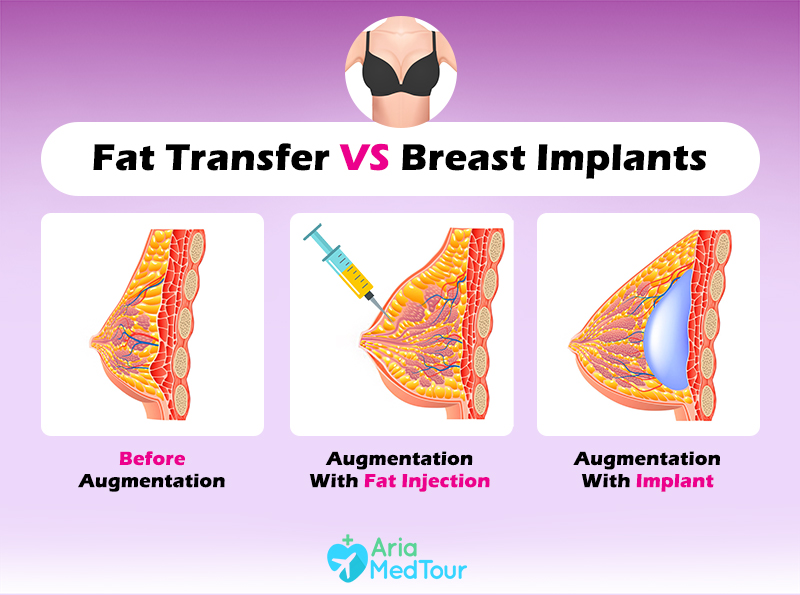

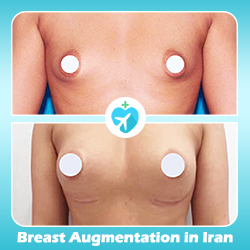






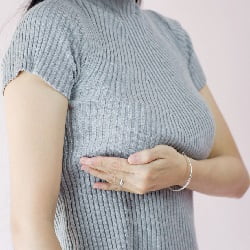


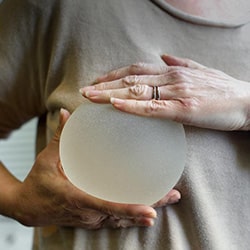
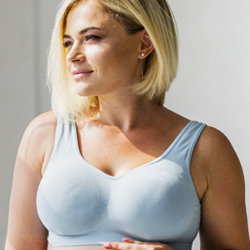
I’m trying to understand the real difference between breast augmentation vs implants. Aren’t they basically the same thing? I also want to know how breast augmentation vs breast implants compare in terms of results and longevity.
While the terms are often used interchangeably, breast augmentation vs breast implants are not exactly the same. Breast augmentation refers to the overall procedure to enhance breast size or shape, which can be done using implants or fat transfer. Implants are one method used in breast augmentation, offering more predictable volume and long-lasting results.
I’m seriously considering breast enhancement, but the pricing is confusing. What factors affect breast implant cost and overall breast enhancement cost? Is there a big difference depending on the technique used?
Breast implant cost can vary depending on the type of implant, surgeon’s experience, clinic location, and anesthesia fees. The total breast enhancement cost also depends on whether implants or alternative techniques are used. During a consultation, your surgeon can provide a personalized cost estimate based on your goals and anatomy.
I’ve been reading a lot about fat transfer vs breast implants and I’m torn. I love the idea of a more natural look, but I’m worried about durability and the fat transfer vs implants cost. How does breast augmentation vs fat transfer really compare?
Choosing between breast augmentation vs fat transfer depends on your expectations. Fat transfer offers a more natural feel and subtle enhancement, while implants provide more dramatic and predictable volume. When comparing fat transfer vs breast implants, it’s also important to consider that fat transfer vs implants cost may differ due to multiple procedures sometimes needed with fat transfer. A detailed consultation helps determine the best option for your desired outcome.